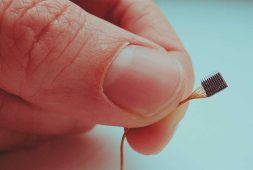If You Hate Needles, This Future Machine Could Deliver Your Future Medications With Just A Gentle Puff Of Air

Regardless of how old you are, you probably don’t like needles. But if you are a baby needing annual vaccines or an adult dependent on insulin, some people have no choice but depend on needles to get medicine and biologics into the body.
Thankfully, scientists have been working to make needles obsolete in some cases by developing new technology that works to get vaccines and other liquid medications into the skin using just a bit of pressure, almost like being hit by a foam toy.
Using powdered vaccines that don’t need refrigeration and a system that uses compressed gas, this new so-called “MOF-Jet” has the ability to easily deliver certain therapeutics – such as those against cancer and other types of diseases – in a painless and less “scary” way.
The idea for this new type of product came about during the pandemic because of boredom no less. As the story goes, the project’s main investigator, Jeremiah Gassensmith, Ph.D., ordered a few pieces of a compressed gas-powered jet injection system to play around with while stuck inside during the lockdown.
Then when the restrictions were lifted and everyone was allowed back on campus, Dr. Gassensmith gave the pieces of the jet to a graduate student in the lab, Yalini Wijesundara, and even gave the instructions, “See what you can do with this.” And boy, did she do something all right.
Although these jeet injectors that were handed to her looked like something out of the future, they were actually items that were once used by the military back in 1960s. However, they were discounted due to being rather painful when used, normally blowing the liquid vaccine back into the face of the person using it rather than to the one it was meant to target.
Thankfully, Wijesundara managed to create something amazing with it, and the medical media in her invention is now called a MOF, or metal-organic framework. Basically, they were teeny tiny cages that could hold a vaccine powder until it could be placed inside a cell. Usually, these are made from gold or tungsten, making them incredibly expensive. However, alongside the team of Wijensundara, they managed to create a way to use zeolite instead, lowering costs.
Wijesundara shared, “We can also store vaccine formulations within it as powders at room temperature, which eliminates the need for the extremely cold temperatures many liquid vaccines require.”
Gassensmith also shared that the blast from the injector feels “like you got hit with a Nerf bullet.” And the team even tried it out on both onions and mice.
By using the MOF-Jet, Wijesundara figured out that cargo release could be tuned by just changing the injector’s carrier gas.
She explained, “If you shoot it with carbon dioxide, it will release its cargo faster within cells; if you use regular air, it will take four or five days.”
“Once we realized that, it opened up a lot of possibilities,” added Gassensmith.
According to a report in SciTechDaily, the research group is now using this method to supply adjuvants and chemotherapeutics as a possible treatment for melanoma, which is the most serious type of skin cancer. Because MOF-Jet can distribute material over a wide area, it may also be able to disperse cancer therapeutic into a melanoma much more evenly than the current therapy, which is normally done with a needle. Depending on the patient’s need, it may also deliver the required medication with a slow or fast-release method. Moreover, depending on the adaptability of the MOF-Jet, it may also allow for a wide range of applications, such as in veterinary or agricultural needs, or maybe even human vaccines or treatments.
The team will also show their study results at the meeting of the American Chemical Society (ACS) in the spring.
See more about this by watching the video below:



